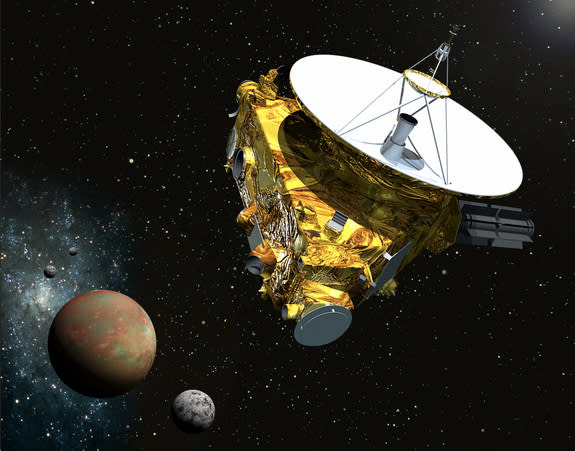 Science and Weather
Science and WeatherPluto-bound probe promises to reveal mysteries surrounding frozen edge of our solar system

After spending much of the last eight years in a deep sleep while travelling through the frigid outer regions of the solar system, NASA’s plucky Pluto-bound probe has finally awakened.
Launched in 2006, The New Horizons probe has travelled over 4 billion kilometres from Earth on its way to Pluto, and is now only 270 million kilometres from reaching its destination.
New Horizons is so far away now that its radio signals take almost 4.5 hours to reach Earth. And while the encounter with the frozen, mysterious world is only slated to occur next July, NASA engineers sent commands to the probe for it to rise from its hibernation and begin preparing for its swing by Pluto.
Packed with a suite of science instruments and cameras, New Horizons will whet our appetite when it gives us our closest views of Pluto and its five moons yet, when it snaps its first photos on Jan. 15th. Expectations are that the images will be better than the blurry, out-of-focus ones Hubble snapped a few years back.
Scientists are keen on getting their first-ever close-up views of Pluto, as it remains mostly a mystery. Is it geologically active? Does it have active, icy geysers?
Hopes are that when the mission does arrive, it will also help resolve a long-standing debate about Pluto’s status as a planet. In 2006, the International Astronomical Union (IAU) took the controversial decision to demote the ninth planet from the sun to a dwarf planet status. Astronomers say that if Pluto were to be discovered today, it would not have been classified as a planet but an icy dwarf like many of its surrounding objects that have since been uncovered and called Kuiper Belt objects.
The Kuiper Belt is a doughnut-shaped region billions of kilometers away from the sun that contains hundreds of thousands of icy objects that are similar in size and location as Pluto. These objects are thought to be frozen leftovers from the time the planets were born some 4 billion years ago.
That’s why astronomers are so keen on getting their first detailed views of Pluto’s never-before-seen surface features. They expect these one-of-a-kind views will help understand how our solar system formed and how planets like Earth were born
Since the early 1970s, poor Pluto has been getting a bad rap as astronomers continued to refine their measurements – noticing that it was appearing to be lighter and tinier with each new observation. The situation came to a head in 2005 when a new Kuiper Belt object, called 2003 UB313, was discovered that appeared to be more massive than Pluto.
This prompted the IAU to decide what the official definition of a planet really should be. What the committee decided on was a strict set of rules that an object had to follow to be considered a bona fide planet:
It has to orbit around the sun
It has to have sufficient mass so that it assumes a round shape
It must have cleared its orbit of other objects.
As a result, Pluto, the asteroid Ceres, and a handful of Kuiper Belt Objects discovered are known as dwarf planets.
For now, it’s a waiting game as the probe continues to narrow the gap to Pluto. Amazingly, the encounter will only last a a frantic few hours, as New Horizons just swings past the frozen world and then continue its journey towards the edge of the solar system, weaving its way through the icy Kuiper Belt and searching for more targets of opportunity.

